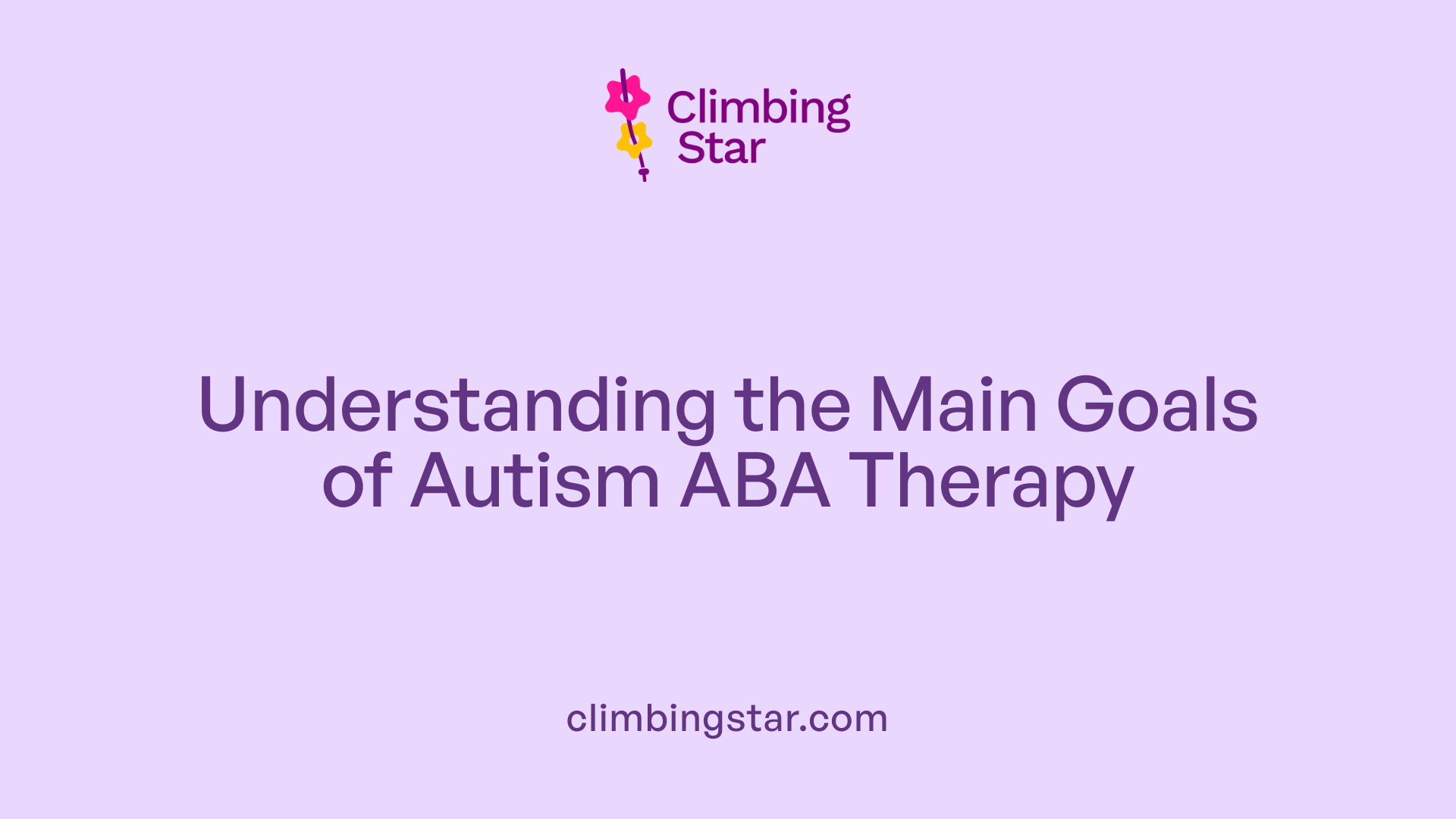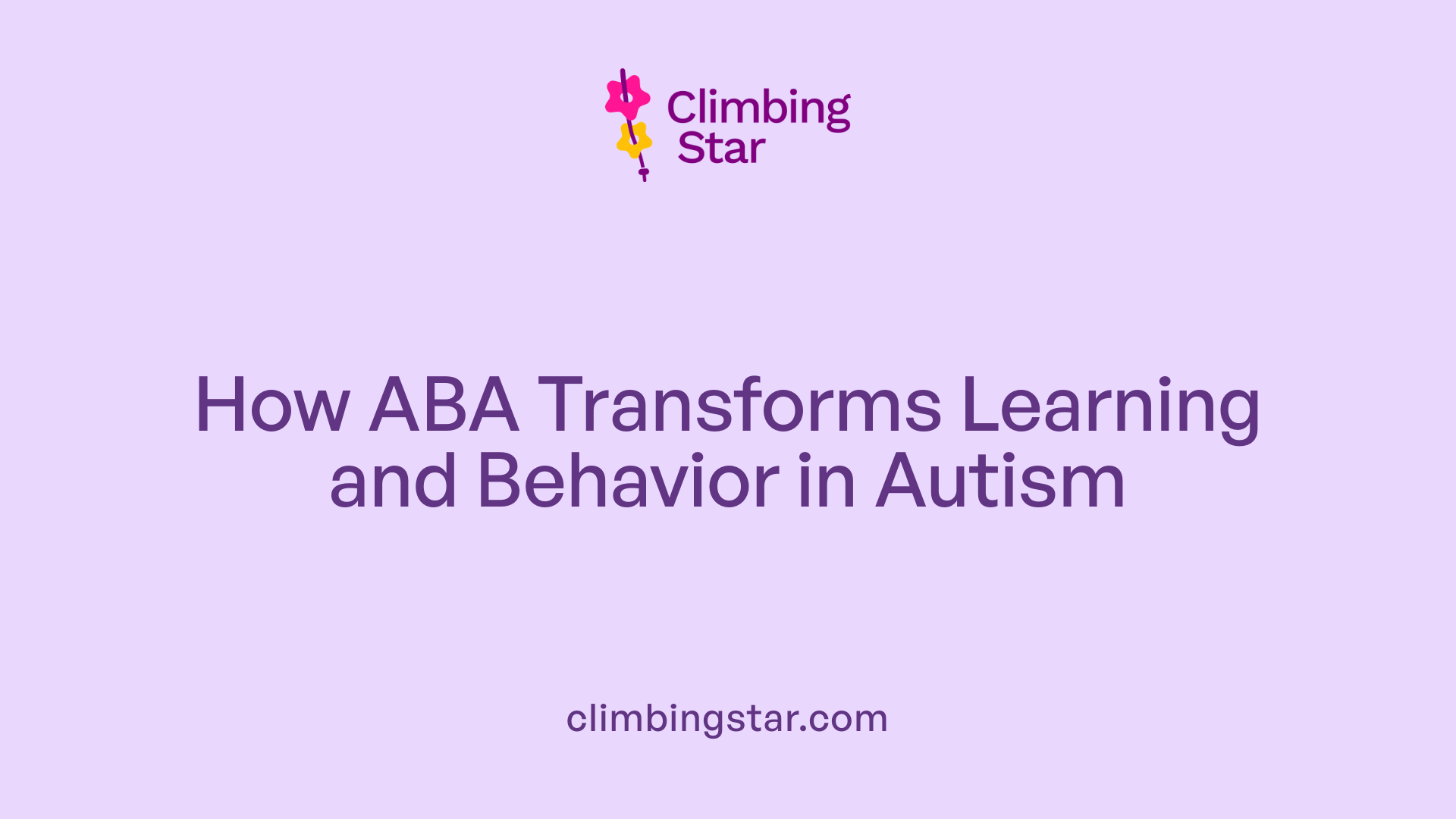Understanding Autism-Related Behavioral Challenges
Autism Spectrum Disorder (ASD) often presents complex behavioral issues that can significantly impact daily living for affected individuals and their families. Addressing these challenging behaviors requires specialized, evidence-based therapeutic approaches designed to improve social, communication, and functional skills while reducing disruptive actions. This article explores the foundational role of Applied Behavior Analysis (ABA) therapy and complementary programs in managing and transforming challenging autism behavior problems, emphasizing personalized care, parent involvement, and multidisciplinary support.
Fundamentals of Applied Behavior Analysis (ABA) Therapy in Autism

What is applied behavior analysis (ABA) therapy and how is it used to help individuals with autism?
Applied Behavior Analysis (ABA) therapy is a science-based approach aimed at understanding how behavior works and how learning occurs through environmental influences. It is widely used to help individuals with autism by increasing positive behaviors and decreasing challenging or disruptive ones.
What are the principles behind ABA therapy?
ABA therapy is built on principles such as positive reinforcement, where desirable behaviors are rewarded to encourage their repetition. Another important principle is the 'A-B-C' model — Antecedent, Behavior, and Consequence — which helps analyze and modify behaviors by identifying triggers and responses.
How are ABA techniques applied?
Techniques in ABA often involve breaking down skills into manageable steps and practicing them in either planned or natural settings. Structured methods like Discrete Trial Training and naturalistic interventions such as Pivotal Response Treatment allow therapists to tailor learning opportunities. Positive reinforcement remains central, using rewards to promote helpful behavior.
How is individualized treatment planning conducted?
Treatment begins with a detailed assessment by a Board Certified Behavior Analyst (BCBA). They design a personalized program based on the child’s unique strengths and needs. Goals may include improving communication, social skills, self-care, and reducing problem behaviors. Progress is closely monitored through data collection to adjust strategies as needed.
What evidence supports ABA's effectiveness?
Extensive research, including randomized controlled trials and meta-analyses, confirms ABA’s effectiveness for many children with autism. Studies have shown that early and intensive ABA therapy can lead to significant gains in socialization, communication, language, and reduce the need for specialized services later in life. ABA's status as an evidence-based best practice is widely recognized by leading health organizations.
Key Goals of Behavior Analysis Therapy for Autism Spectrum Disorder

What are the main goals of behavior analysis therapy for individuals with autism?
Behavior analysis therapy for autism primarily focuses on several important goals. It aims to improve communication abilities, such as expressive and receptive language, enabling individuals to better interact and connect with peers and family.
Social skills enhancement is another major target, helping children with autism form meaningful relationships and navigate social contexts more effectively. The therapy also emphasizes increasing functional and daily living skills including self-care routines, play, academic accomplishments, and motor skills.
Crucially, behavior analysis works to reduce harmful or disruptive behaviors like aggression, self-injury, and tantrums. By analyzing triggers and consequences of behaviors, tailored interventions encourage positive replacements and strategies that promote safety and well-being.
Finally, increasing independence and quality of life is a core objective. Through personalized goals designed by certified analysts, individuals learn skills that allow them to manage their environments, handle transitions, and participate more fully in their communities.
Overall, applied behavior analysis adopts a comprehensive, individualized approach that supports developmental gains and functional competence in children and youth with autism.
How ABA Therapy Facilitates Learning and Behavioral Change

Role of Environmental Factors in Learning
Applied Behavior Analysis (ABA) is rooted in understanding how the environment influences behavior. This approach analyzes the 'A-B-Cs' — Antecedents, Behaviors, and Consequences — to identify triggers that precede behaviors and the outcomes that reinforce them. By modifying environmental factors, ABA therapy helps to shape positive behaviors and reduce negative or disruptive ones.
Techniques Such as Prompting, Shaping, Naturalistic Teaching
ABA employs several teaching techniques tailored to individual needs. Prompting involves providing cues to encourage correct responses, while shaping progressively reinforces closer approximations toward a desired skill. Natural environment teaching harnesses everyday settings to promote learning in a meaningful context, increasing generalization of skills. These techniques support effective acquisition of communication, social, and functional abilities.
Use of Systematic Data Collection and Progress Monitoring
Every ABA program is personalized and designed by Board Certified Behavior Analysts (BCBAs) who rely extensively on data collection. Through continuous monitoring of behaviors and responses, therapists can objectively measure progress. Data guides timely adjustments, ensuring interventions remain effective and aligned with individualized goals.
Skill Acquisition in Communication and Daily Life
ABA therapy targets a broad spectrum of skills vital for independence and quality of life. Clients learn functional communication skills to express needs and reduce frustration-driven behaviors. Daily living skills, social interactions, academic abilities, and motor skills are also developed. Positive reinforcement encourages repetition and mastery of behaviors, thereby promoting meaningful progress.
| Aspect | Description | Impact on Learning |
|---|---|---|
| Environmental Factors | Modifies antecedents and consequences | Shapes behavior by altering context |
| Teaching Techniques | Includes prompting, shaping, and naturalistic teaching | Facilitates skill development and generalization |
| Data Collection & Monitoring | Systematic tracking of behavior and progress | Ensures responsive, individualized treatment |
| Skill Acquisition Focus | Communication, daily living, social and academic skills | Enhances independence and quality of life |
ABA therapy thus translates behavioral science into practical interventions, fostering behavioral change and meaningful learning for individuals with autism.
Professional Providers Behind Autism Behavioral Therapies
Who Typically Provides Behavioral Analysis Therapies for Autism?
Behavioral analysis therapies for autism are primarily delivered by a team of specialized professionals trained in applied behavior analysis (ABA). At the forefront are Board Certified Behavior Analysts (BCBAs), who are responsible for designing individualized treatment plans based on thorough assessments. BCBAs oversee the therapy process ensuring goals are tailored and progress is continuously monitored.
Registered Behavior Technicians (RBTs) and therapists implement the treatment plans directly, carrying out therapy sessions with the child. These providers work under the supervision of BCBAs and need to meet strict certification and training requirements to maintain high standards of care.
In addition to ABA specialists, a multidisciplinary team approach often including licensed speech-language pathologists and occupational therapists enhances treatment effectiveness. Speech therapists address communication challenges while occupational therapists focus on sensory integration and daily living skills, complementing ABA interventions.
Assessment and diagnosis typically come from professionals such as pediatricians, psychologists, neurologists, and psychiatrists who identify the child’s specific developmental needs and establish initial treatment pathways.
This integrated team ensures comprehensive support by combining expertise in behavior, communication, medical, and developmental domains. Training, certification, and ongoing supervision are critical to guaranteeing that therapies remain evidence-based, ethical, and responsive to each child’s evolving needs.
Specialized Behavioral Programs: RUBI Parent Training and Biobehavioral Outpatient
What is the RUBI Parent Training Program?
The RUBI Parent Training Program is a targeted intervention designed specifically for parents and caregivers of children aged 3 to 10 who have autism and exhibit mild-to-moderate behavior challenges. This program emphasizes equipping families with the practical skills needed to reduce problem behaviors and enhance daily living abilities.
How are RUBI sessions structured and what do they focus on?
RUBI involves weekly one-hour sessions with a qualified therapist spanning up to 13 weeks. These sessions foster active parent involvement and focus on three primary goals: preventing problem behaviors, encouraging positive behaviors, and teaching new functional skills. Consistent at-home practice and follow-up support are crucial parts of this process to ensure lasting improvements.
What is the Biobehavioral Outpatient Program?
Designed for children ages 3 to 17 with more complex and severe behavioral needs, the Biobehavioral Outpatient Program offers short-term ABA therapy targeting unsafe or highly disruptive behaviors such as self-injury, aggression, or pica. This program is particularly well-suited for behaviors that require immediate, specialized intervention.
How does the Biobehavioral Outpatient Program operate?
Sessions in this program are flexible, lasting from one hour to two and a half hours, with frequency customized based on the individual child's needs. Therapists collaborate closely with families to identify triggers, improve communication, and develop safety and coping strategies tailored to each child’s unique situation.
Professional Oversight and Family Collaboration
Both RUBI and the Biobehavioral Outpatient Program are led by professionals with expertise in behavior analysis, such as Dr. Erin Olson, ensuring therapies meet high standards of care. Emphasizing family partnership is central to both programs, recognizing that parents’ consistent involvement greatly enhances treatment outcomes.
Functional Behavioral Assessments to Tailor Autism Interventions
What is the Purpose of Functional Behavioral Assessment (FBA)?
Functional Behavioral Assessment (FBA) is a foundational process used in ABA therapy to understand why challenging behaviors occur in children with autism. Its purpose is to identify the specific environmental triggers (antecedents) and the outcomes (consequences) that maintain problematic behaviors. By uncovering these factors, therapists and families gain insight into the function behind behaviors such as aggression, self-injury, or tantrums.
How are Antecedents and Consequences Identified?
Through careful observation and data collection, FBA examines what happens immediately before (antecedent) and after (consequence) a behavior. This helps to pinpoint triggers like sensory overload or demands, as well as what the child gains or avoids through the behavior. Understanding these patterns is critical in targeting interventions effectively.
How is Behavioral Assessment Used to Develop Individualized Plans?
Based on the FBA, Board Certified Behavior Analysts (BCBAs) design personalized treatment plans that address the unique needs of each child. These plans focus on reducing problem behaviors and teaching appropriate alternative skills, such as functional communication, to meet the same needs in a safer and more socially acceptable way.
What Does Functional Analysis Involve?
Functional Analysis is a more controlled method where therapists systematically manipulate environmental variables to confirm the function of behaviors identified during the FBA. By observing how changes in antecedents and consequences affect behavior, this technique provides strong empirical data that guides precise intervention strategies.
How are Assessment Findings Integrated into Customized Interventions?
The information gathered from FBA and Functional Analysis informs an integrated treatment approach that considers biological, environmental, and social factors influencing behavior. Interventions often combine prevention strategies, teaching replacement skills, and carefully planned response methods. This results in a treatment plan that not only reduces harmful behaviors but also promotes positive behaviors tailored to each child's context and learning style.
Evidence-Based Techniques within Behavior Analysis for Problem Behaviors
What Extinction, Non-Contingent Reinforcement, and Differential Reinforcement Entail
Behavior analysis incorporates several proven techniques to address problem behaviors in children with autism. Extinction involves discontinuing reinforcement of a previously rewarded behavior, which gradually decreases its occurrence. Non-contingent reinforcement (NCR) provides reinforcement on a fixed schedule, independent of the child's behavior, reducing motivation for challenging behaviors.
Differential reinforcement encourages desirable behaviors by providing reinforcement selectively, often replacing problematic behaviors. This includes approaches like Functional Communication Training (FCT), which teaches individuals to use communication skills effectively to replace challenging behaviors.
How Functional Communication Training Supports Behavior Change
FCT is a prominent differential reinforcement method wherein children learn alternative, functional ways to express needs or emotions. By teaching communication as a replacement for disruptive behavior, FCT reduces incidents rooted in communication difficulties.
The Role of Response Blocking and Competing Stimulus Assessments
Response blocking prevents engagement in harmful or repetitive behaviors immediately, giving the child an opportunity to redirect their actions to more appropriate behaviors. Competing stimulus assessments help identify stimuli that can effectively compete with and reduce problem behavior by capturing the child’s interest, thereby serving as alternative options.
Using Stimulus Preference Assessments to Enhance Reinforcement
Identifying preferred stimuli is critical to maximizing the effectiveness of reinforcement. Stimulus preference assessments systematically determine which items or activities the child values most, allowing therapists to tailor rewards that strengthen positive behaviors.
Scientific Validation Through Rigorous Research
These ABA techniques are supported by extensive scientific research. Randomized controlled trials, single-case designs, and meta-analyses have demonstrated their efficacy in reducing problematic behaviors and increasing adaptive skills. This robust empirical evidence underpins the widespread adoption of applied behavior analysis as the gold standard for behavioral intervention in autism spectrum disorder.
Prevention, Replacement, and Response Strategies in Behavior Intervention
How do prevention strategies like visual schedules and timers help in behavior intervention?
Prevention strategies aim to reduce the likelihood of challenging behaviors before they start by creating predictable, less overwhelming environments. Tools such as visual schedules and timers provide structure and clear expectations, helping children with autism anticipate transitions and new activities. This predictability lowers stress and anxiety, making challenging behaviors like tantrums or noncompliance less likely to occur.
What are replacement strategies, and how do they promote functional communication and self-regulation?
Replacement strategies focus on teaching alternative, functional skills to serve the same purpose as the problem behavior. Functional communication training (FCT) teaches children appropriate ways to express needs, reducing frustration-driven behaviors. In addition, self-regulation techniques and daily living skills build independence and coping abilities, further minimizing challenging behaviors by providing positive outlets.
How do response strategies utilize reinforcement and extinction?
Response strategies directly address behaviors after they occur. Positive reinforcement rewards appropriate behaviors to increase their frequency. Techniques like extinction involve withholding reinforcement for challenging behaviors, leading to a decrease over time. Combining these with functional behavioral assessments helps identify behavioral causes and tailor responses effectively.
How are disliked tasks embedded within preferred activities to aid behavior change?
Embedding disliked tasks within enjoyable activities helps ease children into challenging demands by associating them with preferred routines. This blending reduces resistance and increases engagement, making task completion more manageable and less stressful.
What role do perseverative interests and generalized reinforcement play in behavior intervention?
Incorporating perseverative interests—strong, focused interests common in autism—into interventions leverages natural motivation to encourage learning and positive behaviors. Generalized reinforcement involves using a variety of rewards, ensuring that motivation is maintained over time and across settings. Together, these approaches enhance the effectiveness and sustainability of behavior support plans.
Emerging Treatments: Skill-Based Treatment (SBT) for Autism
What is Skill-Based Treatment (SBT)?
Skill-Based Treatment (SBT) is a recently developed behavioral therapy approach designed to address challenging behaviors in individuals with autism spectrum disorder (ASD). Unlike some traditional ABA techniques that may focus narrowly on discrete skills, SBT takes a comprehensive approach that targets both behavior modification and skill development. It integrates various components aimed at teaching functional communication and adaptive behaviors safely and efficiently, making it suitable for diverse settings such as homes, schools, and telehealth.
How Are Assessments Conducted in SBT?
SBT begins with a practical functional assessment (PFA) to understand the reasons behind challenging behaviors. This process is enhanced by the use of an interview-informed synthesized contingency analysis (IISCA), which helps identify multiple reinforcement contingencies maintaining the behaviors. These assessments provide a solid foundation for designing individualized intervention plans that effectively address the specific functions of each behavior.
What Role Does Omnibus Functional Communication Response Play?
A central component of SBT is teaching an omnibus functional communication response (FCR). This skill functions as a communication tool to replace various challenging behaviors, addressing multiple underlying functions identified in the assessments. Additionally, SBT includes teaching both simple and complex FCRs, along with tolerance and delay responses that help extend the communication skills into real-life situations, promoting generalization and maintenance of positive behaviors.
How Does SBT Emphasize Trauma-Informed and Compassionate Care?
SBT places a strong emphasis on trauma-informed, compassionate, and assent-based care, focusing on patient affect and safety throughout the treatment process. This approach ensures interventions consider the individual's emotional well-being and provide respectful, empathetic support, which is crucial for building trust and positive therapeutic relationships.
What Does Preliminary Research Indicate About SBT’s Effectiveness?
Research to date—including 21 studies with 87 participants, mostly case series and single-case experimental designs—shows promising but preliminary evidence supporting the efficacy of SBT in reducing challenging behaviors and teaching adaptive skills. The approach's flexibility allows practitioners to tailor interventions to individual needs and contexts, highlighting its potential as a valuable addition to autism behavioral therapies.
Biopsychosocial Approach to Understanding and Managing Autism Behaviors
How Do Biological, Environmental, and Social Factors Interact in Autism?
Understanding behavior in autism requires examining the complex interaction between biological, environmental, and social factors. These elements collectively influence the emergence and maintenance of challenging behaviors such as aggression, self-injury, or noncompliance. Biological aspects include neurological and developmental conditions, while environmental factors encompass settings and triggers around the child. Social influences involve family dynamics and community support.
Why Are Integrated Assessment and Treatment Plans Essential?
Treating challenging behaviors effectively depends on comprehensive, integrated assessments. Functional Behavioral Assessments (FBAs) and practical functional assessments help identify the antecedents and consequences maintaining behaviors. This data informs personalized interventions aimed to reduce problem behaviors and teach adaptive skills. Such integrated planning ensures therapies are tailored to each child's needs and situation.
What Principles Guide Trauma-Informed and Assent-Based Care?
Modern behavioral programs incorporate trauma-informed care, emphasizing sensitivity to patient affect and emotional safety. Assent-based approaches ensure the individual’s cooperation and comfort during therapy, fostering trust and positive engagement. These principles promote compassionate treatment aligned with the emotional needs of the child, reducing potential distress.
How Important Is Consistent Practice at Home and Follow-Up?
Consistency across environments is vital. Programs like RUBI emphasize parent involvement and regular practice of strategies at home, reinforcing gains made in therapy sessions. Follow-up appointments help maintain progress and adjust interventions as needed, enhancing long-term effectiveness.
How Does Therapy Enhance Patient Safety and Affect?
Safety planning is a cornerstone of behavioral interventions for autism, especially in cases involving disruptive or unsafe behaviors. Therapists work closely with families to identify triggers and teach communication and coping skills. These steps not only protect the child but also improve emotional wellbeing and overall quality of life, supporting positive affect during therapy.
Insurance and Access Considerations for ABA and Behavioral Therapies
How does insurance coverage for ABA therapy vary?
Insurance coverage for Applied Behavior Analysis (ABA) therapy varies widely depending on the plan, state regulations, and insurance provider. Many insurance plans offer benefits for ABA services, but the extent and duration of coverage can differ significantly. Typically, coverage prioritizes children diagnosed with autism spectrum disorder (ASD) and related developmental disorders.
Who is primarily covered under ABA insurance policies?
Most insurance policies focus on providing ABA services for children under the age of 21, reflecting the common age range for early intervention and intensive behavioral therapies. Some plans also offer limited coverage for adults, but this is less common and often subject to stricter criteria.
What are the medical necessity criteria and authorization processes?
To access ABA services through insurance, a medical necessity determination is usually required. This process involves detailed assessments and treatment plans developed by certified professionals, such as Board Certified Behavior Analysts (BCBAs). Insurance companies often require documentation of the child's diagnosis, behavioral challenges, and a justification for the recommended ABA therapy hours. Authorization processes may involve periodic reviews and approvals for continued therapy.
Why is accessibility and multidisciplinary support important?
Accessibility to ABA therapy depends on factors such as availability of certified practitioners, regional resources, and insurance networks. Multidisciplinary support, including therapists, caregivers, and medical professionals, improves treatment effectiveness and helps families navigate insurance systems. Programs like the RUBI Parent Training and Biobehavioral Outpatient Program emphasize collaboration to address complex behavioral needs comprehensively.
What role do certified professionals play in securing ABA services?
Certified practitioners, particularly BCBAs, play a crucial role in designing individualized treatment plans, conducting assessments, and documenting progress. Their expertise is essential for meeting insurance requirements, ensuring medical necessity standards are met, and communicating effectively with insurance providers. Their leadership assures a high standard of care and facilitates smoother approval for ABA services.
Transforming Lives Through Evidence-Based Autism Therapies
Challenging behavior problems associated with autism require sophisticated, personalized interventions grounded in scientific research and compassionate care. Applied Behavior Analysis remains a cornerstone of effective treatment, demonstrating remarkable outcomes in skill development and behavior modification. Complementing ABA, specialized programs like RUBI Parent Training and innovative approaches such as Skill-Based Treatment continue to expand therapeutic options suited to diverse needs. Success hinges on collaborative efforts among trained professionals, families, and communities to create stable, supportive environments where individuals with autism can thrive. Ongoing research, comprehensive assessments, and tailored interventions promise continued advancement in unlocking potential and enhancing quality of life for those impacted by autism spectrum disorder.
References
- Therapies for Challenging Behaviors – Autism Center
- Applied Behavior Analysis (ABA)
- Treatment of severe problem behaviour in children with ...
- Applied Behavior Analysis (ABA)
- Skill-based treatment for challenging behavior in autism ...
- Treatment for Behavioral Issues in Autism
- Applied Behavior Analysis (ABA)
- Applied Behavior Analysis in Children and Youth with Autism ...







